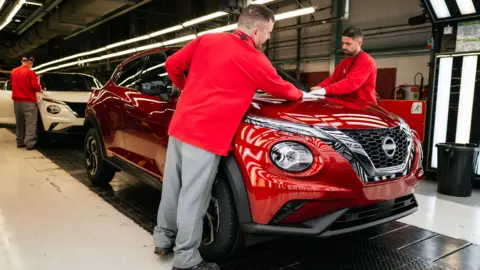Nissan, the renowned Japanese automobile manufacturer, has announced its openness to the possibility of sharing production facilities globally with Dongfeng, its Chinese state-owned partner. This strategic shift underscores Nissan’s efforts to revamp its business model amid declining sales and fierce competition in key markets, particularly in the United States and China, where it has faced mounting challenges.
The move comes in light of Nissan’s recent announcement to lay off approximately 11,000 workers and close seven factories as part of its cost-cutting measures. Although the company did not specify the locations affected by these layoffs, it is a significant part of its broader strategy to realign resources and focus on efficiency. Nissan’s CEO, Ivan Espinosa, reassured employees at a recent conference, stating that there are no immediate plans to alter operations at the Sunderland facility—one of Nissan’s key plants located in the UK. Here, the company continues to work on launching new car models, signaling its intent to maintain a strong presence in the region, at least in the short term.
Despite the recent efforts, Nissan has already faced substantial workforce reductions, with a total of 15% of its global workforce being impacted by these layoffs. In November alone, the company announced an initial round of 9,000 job cuts, signaling its intent to streamline operations. These reductions are reportedly part of a broader cost-saving initiative aimed at cutting global production by 20%. This drastic shift is essential for Nissan as it grapples with a challenging automotive landscape, particularly in China, the world’s largest automobile market, where the company has struggled to gain a foothold amidst a saturated market and intense pricing pressures.
Nissan’s long-standing partnership with Dongfeng has spanned over two decades, with the two companies collaborating on vehicle production in Wuhan, China. The potential to share global production facilities represents an opportunity to leverage both companies’ strengths and navigate the complexities of the current automotive environment more effectively.
As of now, Nissan’s global workforce stands at around 133,500 employees, with about 6,000 of those based in Sunderland. The company’s leadership has undergone significant changes in recent months, including the departure of former CEO Makoto Uchida following failed merger discussions with rival Honda. These negotiations, which aimed at creating a multi-billion-dollar partnership, fell through, prompting a leadership shakeup and the appointment of Espinosa as the new CEO.
Nissan has also recently reported an eye-watering annual loss of 670 billion yen (approximately $4.6 billion or £3.4 billion), exacerbated by external factors such as tariffs imposed during the Trump administration. In a bid to bolster its position and enhance its electric vehicle lineup, Nissan’s battery partner, AESC, has secured a considerable funding package of £1 billion ($1.3 billion) from the UK government to establish a new facility in Sunderland. This plant is envisioned to produce batteries for Nissan’s Juke and Leaf electric vehicle models, contributing to the quest for sustainability within its production processes.
Rachel Reeves, the Chancellor of the Exchequer, noted during a recent visit to the site that this initiative would “deliver much-needed high-quality, well-paid jobs to the North East.” This development indicates a positive outlook for the region’s job market amidst the backdrop of Nissan’s operational challenges.
In summary, Nissan is at a crossroads, navigating through turbulent waters characterized by job layoffs and factory closures while exploring new partnerships that may well redefine its future strategies. The collaboration with Dongfeng could herald a new era in its operations, as the company seeks to stabilize its production and reposition itself within the competitive global auto industry landscape, particularly concerning electric vehicle manufacturing. The coming months will be critical as Nissan strives to rebound and adapt to the fast-evolving automotive market.



